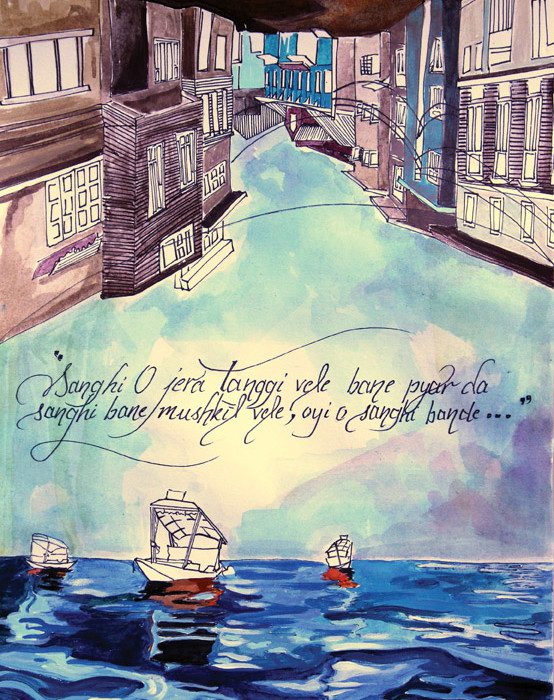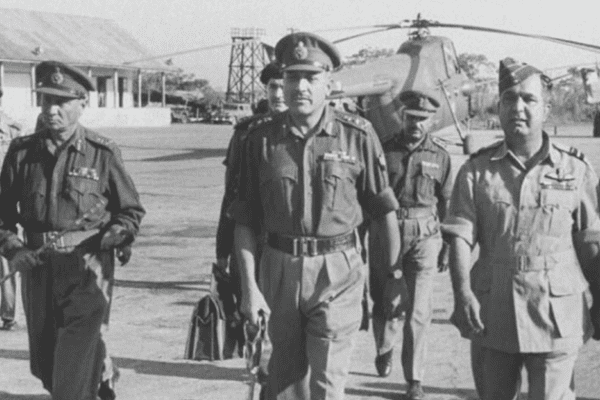Something about a native tongue inspires feelings of kinship and solidarity in ways that can sometimes overcome even the most intractable differences. Anuradha Bhasin Jamwal tells stories of the connective tissue of shared language… from one of the most ‘divided’ places on earth-Kashmir.
It was a song of love that saved his life. In August 2001, when Dwarka Nath, a school teacher from Mendhar in the border district of Poonch, along with his colleague Kirpal Singh, was kidnapped by a group of fierce looking militants, he had thought that he would never return back home. But beyond the terror of guns that the militants wielded, the bonds of language and homeland gave the two abducted teachers a new lease on life.
The militants, sporting long unkempt hair and beards, had singled them out for their religious identity, picked them up from their school and took them deep into the jungle. Dwarka Nath, in an interview a month after his ordeal, said that the militants were constantly in touch with their bosses on the wireless and spoke chaste Pahari, a local dialect of Punjabi spoken on both sides of Line of Control. In between, they spoke to their captives and alternated their threats with friendly casual conversation. Gaining confidence from these friendly moments, Dwarka Nath, hearing the men speak in Pahari over the wireless, spoke to them in the same language. Surprised, one of them asked him where he was from and Dwarka Nath replied that his family hails from Gora village in Sudhnoti, which is now a part of Pakistan Administered Kashmir (PAK). One of the militants, who also hailed from the same area, was overjoyed at this and for quite some time, they conversed in their shared language about shared language and about culture and pride and they somehow stumbled into a discussion about ‘saiful malook’, the popular folk songs of the region. Dwarka Nath, who is endowed with a melodious voice, gave into the temptation to sing a few songs and one of them – a song of love, family relationships and friendship – brought tears to the eyes of their captors. Less than two days after their captivity, the school teacher sang, “Sanghi o jera tanggi vele bane pyar da/ Sanghi bane mushkil vele, oyi o sanghi bande…” (Loosely translated, it says “a companion in despair, with all his compassion, one who befriends in adversity, is a true companion….”); as he sang, all animosity melted and the militants not only released them, but they also exchanged their shoes and watches with them as a sign of friendship.
One of the militants, who also hailed from the same area, was overjoyed at this and for quite some time, they conversed in their shared language about shared language and about culture and pride and they somehow stumbled into a discussion about ‘saiful malook’, the popular folk songs of the region.
The formidable and almost impenetrable borders fail to divide people who share common culture and shared pride – of language, ideas, lifestyles and homeland. It didn’t quite surprise me to see inexplicable joy in the eyes of Tariq Masud, Jammu-born former bureaucrat in Pakistan Administered Kashmir, when he located his ancestral house, bringing back the nostalgia of his early boyhood. I’d heard of stories of Jammu-born people in Pakistan making a mandatory trip to a fort on a mound while visiting Sialkot, only to see the lights of Jammu city and satiate their nostalgic urge to maintain their bonds with the homeland. On my first ever visit to Pakistan in 2000, the scale of immense nostalgia, however, did come as a surprise for me. Five decades after the partition and the related bloody massacres of Jammu and mass migration of Muslims to various towns and cities of Pakistan, it was revealing that the bitter memories had receded in comparison to the warmth for the homeland and the language. It was at the home of the late, Jammu-born Farooq Haider that I met several people who had a Jammu connection. A gentleman I met was thrilled to see me and tried to speak in Dogri, the main native language of Jammu, and almost everybody– even those born after partition but having inherited the nostalgia of their ancestors – wanted to know what Jammu was like: it’s by-lanes, its famous ponds, its picnic grounds on the famous Canal and its cool mid-summer evening breezes called Duddu.
In Rawalpindi and Lahore there is a sizeable population of old Jammu-ites knit close together. Many of them meet regularly to reminiscence about old memories of the city even as it cruelly betrayed them in 1947. They talk about famous landmarks– including two cinema halls, one of which was brought down two decades ago and replaced with a hotel and revolving restaurant – about open grounds that no longer exist and about day trips to Sialkot, less than an hour’s train journey from Jammu. Some of the old timers speak with a distinct Dogri accent that is so familiar on this side and yet they proudly proclaim they are ‘Kashmiris’, a political identity they love to wear on their sleeve, oblivious of the vast political divide of Jammu versus Kashmir on this side of the Line of Control.
I’d heard of stories of Jammu-born people in Pakistan making a mandatory trip to a fort on a mound while visiting Sialkot, only to see the lights of Jammu city and satiate their nostalgic urge to maintain their bonds with the homeland.
Homeland is a memory of a beautiful place etched in hearts, vibrant with imagination, longing and imagined pride, as Tariq Masud reveals by sharing his experience of returning to Jammu after sixty years via Wagah border. “As we drove past the Punjab border and entered Lakhanpur, the gateway to Jammu and Kashmir, I felt the best fields of Kathua were the best ever scenic splendor I’d ever laid my eyes on,” he said. He said this even as he is fully aware that the journey from Lakhanpur to Jammu offers the most uninteresting landscapes, “….but, for me it assumed a new meaning altogether…”
The memory of a lost and longed for homeland speaks through places, events and words unforgotten. Pakistan’s Queen of Ghazals, Mallika Pukhraj was born in the small hamlet of Hamirpur near Akhnoor, forty kilometres from Jammu city, on the banks of Chenab and spent many years in Jammu city as a court singer in Jammu Maharaja’s palace before she fled, accused of a palace intrigue. The village with its absolute Muslim population was totally abandoned after 1947 and submerged and ravished in the floods of 1991. Four years before that Mallika Pukhraj made a special visit to Jammu, though it was impossible for her to visit her ancestral village bang on the border. She said she felt totally rejuvenated walking through the old famous by-lanes of the city and refreshing her old memories of youthful days. Throughout her singing career, she kept Jammu alive, singing not just ghazals but also Dogri folk songs, which are popular on both sides of the border. Today, der daughter Tahira Syed continues to sing both ghazals and Dogri songs that Pukhraj passed on to her as part of the collective heritage of a place that was a part of her till death. Her songs keep that love and bonding across the barriers alive even today, kindling and re-kindling nostalgia, passed on like a family heirloom, in the younger post-partition generations.














